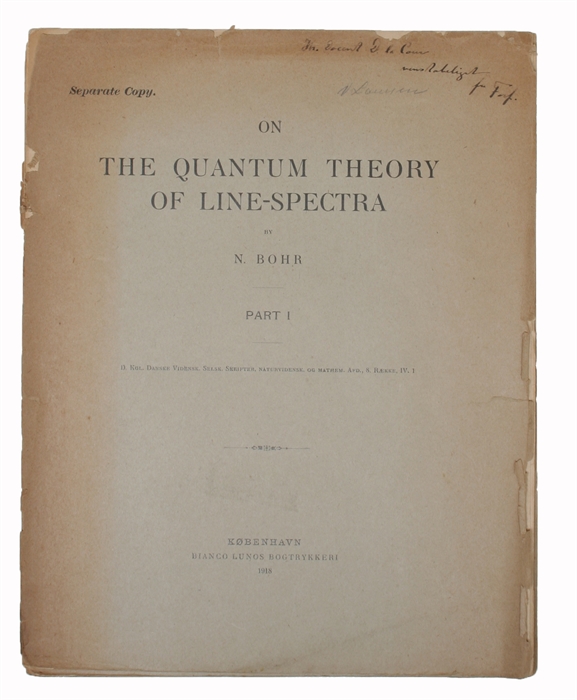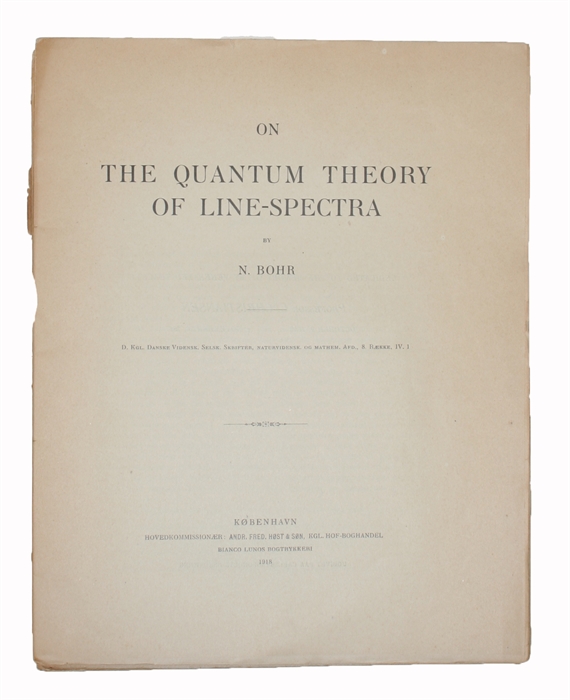BOHR'S CORRESPONDENCE PRINCIPLE - PRESENTATION-COPIES
BOHR, NIELS.
On the Quantum Theory of Line-Spectra. Part I-II. [Off-print from "D. Kgl. Danske Vidensk. Selsk. Skrifter".
Copenhagen, Bianco Lunos, 1918.
4to. Both parts uncut and in the original printed wrappers. Wrappers detached and with small nicks and tears to extremities. Internally fine and clean. Part I unopened. 36 pp. + pp. (37) - 100.
First editions, author's off-prints (with "Separate Copy" printed to front wrappers), presentation-copies, of the first two parts of Bohr's seminal work "On the Quantum Theory of the Line-Spectra" (which appeared in three parts and which was never finished, the third part of which, published 4 years later, is almost never found in presentation-sets), in which Bohr gave his first clear presentation of his groundbreaking "correspondence principle": "Which would play a pivotal role in the later development of atomic theory and its transformation into quantum mechanics." (Kragh, Quantum Generations, p. 56). It eventually became a cornerstone in the quantum mechanics formulated by Heisenberg and Schrödinger. "There was rarely in the history of physics a comprehensive theory which owed so much to one principle as quantum mechanics owed to Bohr's correspondence principle" (Jammer 1966, p. 118).
The evolution of quantum theory is divided into two distinct periods; from 1900 to 1925, usually referred to as the period with the old quantum theory still grounded in classical physics and the second period with quantum mechanics from 1925 onwards.
The general rules of quantum mechanics are very successful in describing objects on an atomic level. But macroscopic systems are accurately described by classical theories like classical mechanics and classical electrodynamics. If quantum mechanics were to be applicable to macroscopic objects, there must be some limit in which quantum mechanics reduces to classical mechanics. Bohr's correspondence principle demands that classical physics and quantum physics give the same answer when the systems become large.
"A major tool he developed for dealing with quantum problem, [...], was the correspondence principle, which establishes links between predictions of the classical theory and expectations for the quantum theory." (Pais, Niels Bohr's Times, p. 20.). In this sense, the correspondence principle is not only an exceedingly important methodological principle, it also represents the transition to quantum mechanics and modern physics in general and it became the cornerstone of Bohr's philosophical interpretation of quantum mechanics which later would be closely tied to his thesis of complementarity and to the Copenhagen interpretation. Another version of the correspondence principle lives on in philosophical literature where it has taken form as a more general concept representing a development of new scientific theories.
"By 1918 Bohr had visualized, at least in outline, the whole theory of atomic phenomena. ... He of course realized that he was still very far from a logically consistent framework wide enough to incorporate both the quantum postulates and those aspects of classical mechanics and electrodynamics that seemed to retain some validity. Nevertheless, he at once started writing up a synthetic exposition of his arguments and of all the evidence upon which they could have any bearing; in testing how well he could summarize what was known, he found occasion to check the soundness of his ideas and to improve their formulation. In the present case, however, he could hardly keep pace with the growth of the subject; the paper he had in mind at the beginning developed into a four-part treatise, 'On the Theory of Line Spectra', publication of which dragged over four years without being completed; the first three parts appeared between 1918 and 1922 [of which the two first from 1918 are offered here], and the fourth, unfortunately, was never published. Thus, the full impact of Bohr's view remained confined to the small but brilliant circle of his disciples, who indeed managed better than their master to make them more widely known by the prompter publication of their own results" (D.S.B. II: 246-47).
Inscribed to "Hr. Docent D. la Cour/ Venskabeligst/ fra/ Forfatteren" on both front wrappers. The renowned Danish physicist and meteorologist Dan la Cour (1876-1942), was the son of the great Poul la Cour (1846-1908), who is considered the "Danish Edison". Dan la Cour was the assistant of Niels Bohr's father, Christian Bohr, and a well known scientist. From 1903, he was head of the department of the Meteorological Institute, and from 1923 leader thereof. From 1908 he was Associate Professor at the Polytechnic College. His original scientific works are highly respected, as are his original apparati for measuring earth magnetism which are considered highly valuable. "His original intelligence, which in many ways resemble that of his father, also bore fruit in his patenting of various inventions: the "Pyknoprobe", developed to quickly determine the different layers of the sea; a use of termite in quickly heating food and drinks out in the open under unfavourable weather conditions." (From the Danish Encyclopaedia - own translation). He wrote a number of important and esteemed works and was member of the Danish Scientific Academy as well as many prominent international scientific commissions of meteorology and geophysics (i.e. president of the International Geodetical and Geophysical Union). He was also honorary Doctor at the George Washington University.
Rosenfeld, Bohr-Bibliography, 15.
Order-nr.: 46542


